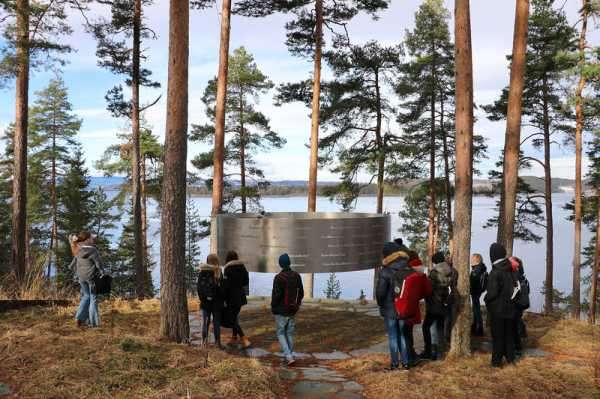
The first 'Lysninga' [the clearing] memorial was unveiled in the summer of 2015, with the names and ages of the majority of the 69 victims – but a row developed over a further memorial, a physical cut in the island (Photo: Wikimedia)
On June 18 this year, prime minister Jonas Gahr Store finally inaugurated a memorial to commemorate the victims of Europe’s most infamous anti-Muslim racist murderer Anders Behring Breivik, who killed more than 77 people — primarily from Norway’s Social Democratic youth organisation — as he thought they were “enablers of Islamisation”.
Some had wished it would happen a year earlier, on July 22 in 2021, which marked the 10th anniversary of the worst violent attack that happened in Norway post-World War 2 and also marks the most violent attack drawing on anti-Muslim conspiracy theories.
But a legal battle between locals on the one hand and the state and the labour youth organisation on the other side postponed the inception of the memorial in remembrance of the victims of Anders Behring Breivik.
The traumatised plaintiffs had argued that the memorial would prolong their trauma.
Before killing 88 people and injuring more than 200 others in a combined car bomb attack on the government quarter of Oslo and later on the island of Utøya, the perpetrator Breivik had published a 1,518-page manifesto, which laid out his motivations that were primarily shaped by the great replacement and white genocide conspiracy theory, a belief that immigration by people of colour and especially Muslims combined with falling white birth rates and the promotion of multiculturalism are all part of a deliberate plot to destroy the “white race.”
This manifesto has since influenced other violent white supremacists that mimicked Breivik, be it the killer of El Paso, the mass murderer of the Christchurch attack in New Zealand, or more recently the shooting in Buffalo/New York.
The deadly violence of Norwegian Breivik, who has since spent his time in prison, showed that Islamophobia does not only harm Muslims but every single part of society that stands for defending the human rights of the disenfranchised, first and foremost refugees and the immigrant working poor.
Breivik, unlike the murderer of New Zealand, who stormed a mosque to kill 51 praying people, targeted a government building and killed another 69 mostly teenage participants who were camping at the Labour Party’s Workers’ Youth League (AUF)’s annual summer camp, as he believed that they were the future enablers of Islamisation.
Four years after the attack had happened, the Workers’ Youth League hosted its first summer camp on Utoya since the attack.
Originally, the government had intended to quickly establish two public memorials soon after the attack had happened.
One was supposed to be in Oslo, where eight people were killed, and one near Utoya, where 69 people were killed. While the government had expected that the construction would take just a few years, 10 years later neither of the official national memorials had been built.
While meanwhile even others such as the social-democratic mayor of the Austrian city of Wiener Neustadt, Bernhard Müller, had opened the Utøya Park in remembrance of the attacks in May 2012, less than a year after the violent attacks had taken place, inviting the ambassador of Norway to the opening ceremony, the legal battle between the local community that feels traumatised and the Workers’ Youth League’s lawyer continues.
For the latter, a national memorial would be “unfortunately more important than ever” given the rise of the far-right in Europe and the United States.
And he adds: “A national memorial is the strongest symbol a state can use to tell future generations that society will not forget what happened.”
Finally, in February of 2021, a Norwegian court ruled that the benefits of the memorial outweighed the traumas it might revive with the local community that had helped on that day.
Nearly 11 years after the attack, the memorial is now finalised, reminding visitors of the victims of one of the most violent single-handed attacks that have become a global pioneer in violent Islamophobia.
This is an indeed necessary and important step in the spirit of the new UN resolution defining 15 March as the International Day to Combat Islamophobia, urging member states “to organise and support various high-visibility events aimed at effectively increasing awareness, at all levels, about curbing Islamophobia.”
Source: euobserver.com



